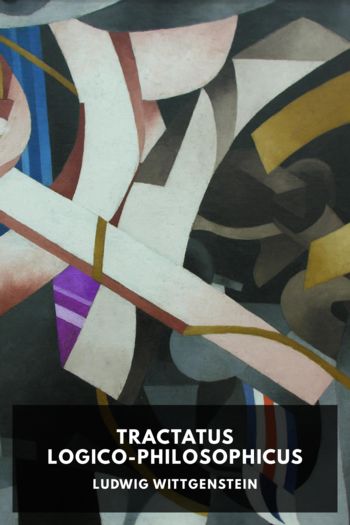Tractatus Logico-Philosophicus - Ludwig Wittgenstein (top 10 ebook reader TXT) 📗

- Author: Ludwig Wittgenstein
Book online «Tractatus Logico-Philosophicus - Ludwig Wittgenstein (top 10 ebook reader TXT) 📗». Author Ludwig Wittgenstein
The process of calculation brings about just this intuition.
Calculation is not an experiment.
6.234Mathematics is a method of logic.
6.2341The essential of mathematical method is working with equations. On this method depends the fact that every proposition of mathematics must be self-evident.
6.24The method by which mathematics arrives at its equations is the method of substitution.
For equations express the substitutability of two expressions, and we proceed from a number of equations to new equations, replacing expressions by others in accordance with the equations.
6.241Thus the proof of the proposition 2×2=4 runs:
( Ω ν ) μ ′ x = Ω ν × μ ′ x Def.
Ω 2 × 2 ′ x = ( Ω 2 ) 2 ′ x = ( Ω 2 ) 1 + 1 ′ x = Ω 2 ′ Ω 2 ′ x
= Ω 1 + 1 ′ Ω 1 + 1 ′ x = ( Ω ′ Ω ) ′ ( Ω ′ Ω ) ′ x
=Ω′Ω′Ω′Ω′x=Ω1+1+1+1′x=Ω4′x.
6.3Logical research means the investigation of all regularity. And outside logic all is accident.
6.31The so-called law of induction cannot in any case be a logical law, for it is obviously a significant proposition.—And therefore it cannot be a law a priori either.
6.32The law of causality is not a law but the form of a law.2
6.321“Law of Causality” is a class name. And as in mechanics there are, for instance, minimum-laws, such as that of least actions, so in physics there are causal laws, laws of the causality form.
6.3211Men had indeed an idea that there must be a “law of least action,” before they knew exactly how it ran. (Here, as always, the a priori certain proves to be something purely logical.)
6.33We do not believe a priori in a law of conservation, but we know a priori the possibility of a logical form.
6.34All propositions, such as the law of causation, the law of continuity in nature, the law of least expenditure in nature, etc. etc., all these are a priori intuitions of possible forms of the propositions of science.
6.341Newtonian mechanics, for example, brings the description of the universe to a unified form. Let us imagine a white surface with irregular black spots. We now say: Whatever kind of picture these make I can always get as near as I like to its description, if I cover the surface with a sufficiently fine square network and now say of every square that it is white or black. In this way I shall have brought the description of the surface to a unified form. This form is arbitrary, because I could have applied with equal success a net with a triangular or hexagonal mesh. It can happen that the description would have been simpler with the aid of a triangular mesh; that is to say we might have described the surface more accurately with a triangular, and coarser, than with the finer square mesh, or vice versa, and so on. To the different networks correspond different systems of describing the world. Mechanics determine a form of description by saying: All propositions in the description of the world must be obtained in a given way from a number of given propositions—the mechanical axioms. It thus provides the bricks for building the edifice of science, and says: Whatever building thou wouldst erect, thou shalt construct it in some manner with these bricks and these alone.
(As with the system of numbers one must be able to write down any arbitrary number, so with the system of mechanics one must be able to write down any arbitrary physical proposition.)
6.342And now we see the relative position of logic and mechanics. (We could construct the network out of figures of different kinds, as out of triangles and hexagons together.) That a picture like that instanced above can be described by a network of a given form asserts nothing about the picture. (For this holds of every picture of this kind.) But this does characterize the picture, the fact, namely, that it can be completely described by a definite net of definite fineness.
So too the fact that it can be described by Newtonian mechanics asserts nothing about the world; but this asserts something, namely, that it can be described in that particular way in which as a matter of fact it is described. The fact, too, that it can be described more simply by one system of mechanics than by another says something about the world.
6.343Mechanics is an attempt to construct according to a single plan all true propositions which we need for the description of the world.
6.3431Through their whole logical apparatus the physical laws still speak of the objects of the world.
6.3432We must not forget that the description of the world by mechanics is always quite general. There is, for example, never any mention of particular material points in it, but always only of some points or other.
6.35Although the spots in our picture are geometrical figures, geometry can obviously say nothing about their actual form and position. But the network is purely geometrical, and all its properties can be given a priori.
Laws, like the law of causation, etc., treat of the network and not what the network describes.
6.36If there were a law of causality, it might run: “There are natural laws.”
But





Comments (0)